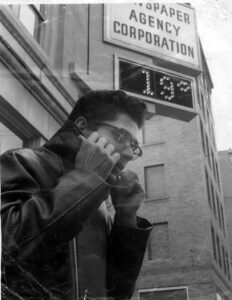(Aliah Mohmand is a student with an interest in Peoples Temple. Her research has resulted in multiple projects regarding the aftermath of the Jonestown tragedy. Aliah attends Kalamazoo College, pursuing studies in History and Finance. Her other articles in this edition of the jonestown report are Reconstructing the Jonestown Narrative: The Story of the 1978 Guyana Inquest and What More Is Left to Learn? A Review of Cult Massacre. Her full collection of articles for this site may be found here. She may be reached at aliahmohmand@gmail.com.)
In the latest Jonestown documentary, Cult Massacre: One Day in Jonestown, former Washington Post correspondent Charles Krause claimed that “he was the first journalist to be able to go back to [Jonestown] to see what happened” after the mass deaths.
The truth is not as grandiose.
Unbeknownst to most viewers, Krause in actuality shares that claim with another journalist. Within the first press pool to visit Jonestown was Guyanese journalist and Caribbean News Agency (CANA) correspondent, Mohamed Hamaludin.
*****

I first became aware of Hamaludin’s coverage of Jonestown from my conversations with Mike and Tim Carter in 2023. Mike Carter told me of his vague recollections of an interview with a Guyanese official, whom Tim identified as Mohamed Hamaludin, a Guyanese journalist associated with CANA (which was, in turn, associated with Reuters) and the Guyana Chronicle—Guyana’s national newspaper. Amid crowds of ruthless reporters from all corners of the world, both brothers remarked that Hamaludin was one of the very few journalists who treated them as “human beings.” Tim graciously sent me photographs of the article Hamaludin filed on them, prompting my interest in locating the journalist himself.
Hamaludin’s articles depict a Guyanese perspective on the tragedy. Furthermore, in contrast to much of the American media’s rampant sensationalism and misinformation, Hamaludin’s early reporting avoided many unnecessary exaggerations.
Yet Hamaludin’s connection to Jonestown extends well beyond his coverage of the tragic aftermath. Like countless other Guyanese officials and journalists, Hamaludin, too, was a subject of the Temple’s PR campaign in Guyana. Memoranda left behind in the Temple’s Lamaha Garden headquarters in Georgetown reveal the Temple’s repeated attempts to persuade Hamaludin to write a positive article on the Temple’s Jonestown project. Temple leaders such as Sharon Amos and Mike Prokes regarded their interactions with Hamaludin as largely pleasant. Other notes discuss the possibility of inviting Hamaludin to visit Jonestown. Despite their attempts—and even after a drafted press release—no article was published.
However, when Congressman Leo Ryan and his delegation arrived in Guyana, Hamaludin was put into close contact with Peoples Temple once again. Hamaludin was originally allotted a seat on the small plane that would carry Ryan and a select number of relatives and members of the press into Port Kaituma. Yet in a last-minute change of plans, the Government of Guyana decided to give his seat to an Information Service Officer, Neville Annibourne.
Following the mass deaths, Hamaludin was selected as a part of the first press pool to go into Jonestown, representing the Caribbean media, and such, was one of the first outsiders—among the Guyanese Defense Forces, local Amerindians, and a limited number of American and Guyanese officials—to witness the extent of the tragedy. He encountered Hyacinth Thrash and Grover Davis, two elderly African American survivors who still had not departed for Georgetown, and was able to interview them.
Meanwhile, survivors and officials were being airlifted from Port Kaituma back to Georgetown, and although Krause managed to secure a seat, Hamaludin was unable to do so. Ironically, this delay presented an advantage, as Hamaludin was able to file his story over the police’s radio line to CANA before anyone else could do so. Eventually, Hamaludin returned to Georgetown and came across the Carters, whom he interviewed along with other survivors.
Undeniably, even for an acclaimed journalist like Hamaludin, Jonestown was the “greatest highlight of [his] career.” With the world’s attention directed towards Guyana, Hamaludin could have continued to spur on story after story. Nevertheless, as a reputable journalist, Hamaludin, obviously, could not fuel the media’s Jonestown fever forever. He simply had to “move onto the next big story.”
*****
In his packet of statements for the press after his suicide in March of 1979, Mike Prokes included a transcript of a November 25, 1978, Guyanese radio broadcast on Jonestown that was attributed to Hamaludin with this handwritten annotation:
Hamaludin is one of the most respected journalists in Guyana and the Caribbean. This is the most accurate [story] approved by a government.